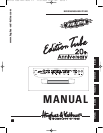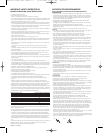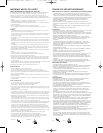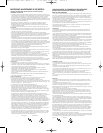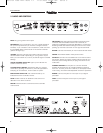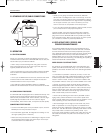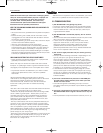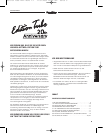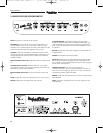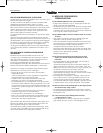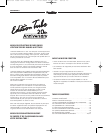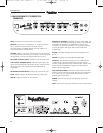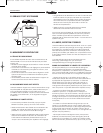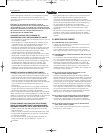
7
ENGLISH
7
EDITION TUBE-MANUAL
2.0 STANDARD SETUP/CABLE CONNECTIONS
3.0 OPERATION
3.1 SELECTING SOUNDS
When you’re ready to tweak the settings for both of the
fundamental sounds that the EDITION TUBE has to offer, we
recommend you proceed as follows:
• Dial in all your sound settings with the guitar’s volume
knob turned all the way up so that it give the amp the
highest possible level to work with.
• First concentrate on tuning the CLEAN channel VOLUME
knob to dial in the desired volume level and amount of
overdrive.
• Once you’re satisfied with that sound, activate the LEAD
channel and use the GAIN knob to shape the second
fundamental sound to suit your taste.
• Now adjust the LEAD MASTER to dial in the desired
balance of levels between the LEAD and CLEAN channels.
3.2 USING SIGNAL PROCESSORS
The EDITION TUBE is equipped with a serial effects loop. This
means that the entire preamp signal is routed to the FX
device and processed there. For this reason, use only high-
quality signal processors that do not color the signal
unnecessarily, add undue noise, or impair its sound quality.
CONNECTING EFFECT DEVICES:
• Connect the SEND jack to the processor‘s input, and the
RETURN jack to the processor‘s output.
• To avoid noise, signal loss, and signals from being cut off,
use high-quality patch cords only.
• Make sure the processor is not distorting the signal. Check
the processor's level meter and use its input and output
controls to dial in a suitable level.
• Unless you’re going for bizarre lo-fi effects, distortion
devices are not designed for use in an FX loop. As a rule
of thumb, any kind of device that compresses the signal
should be connected first in the signal chain. Depending
on the type of effect you want to achieve, you may
want to connect a compressor to the amp's input.
• If you are using several processors or stomp boxes, ensure
you connect them in the proper sequence.
Volume pedals, wah-wahs and the like evoke a slightly
different sound and elicit a different response when you
plug them into the EDITION TUBE’s front panel input rather
than the effects loop. Both can sound hip, so which option
you choose is a matter of personal preference.
4.0 REPLACING TUBES, SERVICE AND
PREVENTIVE MAINTENANCE
Your EDITION TUBE features factory-equipped EL84 and
12AX7A tubes. They are first burned in and then checked
for their electrical and mechanical properties (micropho-
nics), selected and matched, and then given a final audio
and response test once they have been installed in a
EDITION TUBE. One of the most important steps in the testing
process is power tube matching, i.e. selecting and pairing
tubes with identical characteristics.
WHEN SHOULD YOU REPLACE TUBES?
The tubes in your EDITION TUBE are of exceptionally high
quality and will last extremely long. If you do encounter a
problem, first check whether one of the following situations
apply:
• Is the defect a problem caused by a faulty or worn-out
tube, or is there actually a peripheral problem, for instance
a defective speaker cable that caused damage to the
tube? If this is the case, unless you correct the defect first,
the problem will recur once you have installed a new tube.
• Did the AC power supply fluctuate during operation?
Whereas digital equipment often malfunctions when the
power supply dips below a minimum value, all-tube amps
tend to malfunction when the power level rises above a
certain value. Generators and faulty high-power circuits
often cause these power fluctuations.
• Did a fuse trip although there was no plausible cause?
Aging fuses, particle ionization in the tube or spark-over
due to power spikes may cause this type of problem. In this
case, replacing a tube will not solve the problem.
• Old tubes begin to show signs of wear after they have
been in operation for a very long time: increased micro-
phonics and noise, treble loss, weak power output, muddy
sound, etc. are all indicators of pending tube failure. Power
amp tubes wear out faster than preamp tubes. If you
encounter these problems, replace the tubes. Not only do
old tubes sound bad, they also have a tendency to fail
altogether.
Edition Tube Anni Manu 1.1 11.01.2005 12:26 Uhr Seite 7



